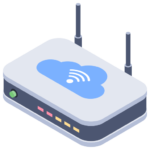Types of Network Devices

In the ever-expanding digital landscape, where connectivity reigns supreme, network devices serve as the unsung heroes orchestrating seamless communication. From the humble router in your home to the sophisticated switches powering global enterprises, these devices form the backbone of modern connectivity. In this comprehensive guide, we delve into the world of network devices, exploring their types, functions, and pivotal role in shaping the digital age.
Types of Network Devices
1. Routers

Routers stand as the gatekeepers of networks, directing traffic between different networks. They analyze data packets and determine the most efficient path for them to reach their destination. In homes and small businesses, routers often combine multiple functions, serving as a gateway to the internet, wireless access point, and sometimes even a firewall.
2. Switches

Switches operate at the data link layer of the OSI model, facilitating communication within a single network. Unlike hubs that simply broadcast data to all connected devices, switches intelligently forward data only to the intended recipient, optimizing network performance. They are essential for creating efficient local area networks (LANs) in both home and enterprise environments.
3. Hubs
While largely outdated in modern networks, hubs once played a crucial role in early Ethernet setups. Unlike switches, hubs lack the intelligence to direct data selectively, instead broadcasting incoming data packets to all connected devices. This leads to unnecessary network congestion, making switches the preferred choice for most networking scenarios today.
4. Modems

Modems serve as the bridge between digital devices and the analog signals transmitted over communication lines such as telephone lines or cable systems. In residential settings, cable modems and DSL modems convert analog signals from ISPs into digital data for devices to interpret, enabling high-speed internet access.
5. Access Points
Access points (APs) extend the reach of wireless networks, providing wireless connectivity to devices within their range. They are commonly used in environments where running cables is impractical or cost-prohibitive, such as offices, campuses, and public spaces. Access points may operate standalone or as part of a larger wireless network infrastructure.
6. Network Interface Cards (NICs)

Network Interface Cards are hardware components installed in devices to enable them to connect to a network. Whether integrated into the motherboard or added as expansion cards, NICs facilitate communication by providing devices with unique MAC addresses and the ability to send and receive data over the network.
If you are reading this, then why not read some more relevant articles given below?
The Role of Network Devices
network devices are the linchpin holding together the fabric of modern connectivity. They enable seamless communication, facilitate the exchange of data, and empower individuals and organizations to access resources and services across vast distances.
Scalability: Network devices are designed to scale alongside the evolving needs of users and businesses. Routers, switches, and access points can be expanded or upgraded to accommodate growing network demands, ensuring that connectivity remains robust and reliable even as requirements change.
Security: Network devices play a pivotal role in maintaining the security of digital infrastructure. Routers and firewalls filter incoming and outgoing traffic, enforcing access control policies and safeguarding networks against cyber threats. Encryption protocols implemented in modems and routers protect sensitive data during transmission, mitigating the risk of unauthorized access.
Performance Optimization: Through intelligent packet routing and data management, network devices optimize the performance of networks, minimizing latency and maximizing throughput. Switches ensure efficient data delivery within local networks, while routers dynamically adjust routing paths to avoid congestion and bottlenecks, ensuring smooth communication flow.
Connectivity Everywhere: With the proliferation of wireless technology, network devices have extended connectivity to virtually every corner of the globe. From densely populated urban centers to remote rural communities, access points and wireless routers enable individuals to stay connected regardless of their location, driving inclusivity and fostering collaboration.